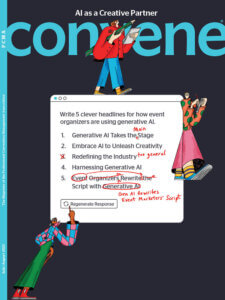A year ago, if her team had asked to identify the conference session topics that rank as the most popular with attendees who are in vice president roles, Megan Finnell would have shrugged her shoulders. “I would’ve said, ‘This data is way too complex,’” she told Convene. “I would have to spend way too many hours digging through this to tell you.”

Part of our July/August cover and CMP Series. (Sergio Membrillas illustration)
Today, Finnell, CMP, HMCC — who is director of meetings and conferences for the Medical Group Management Association (MGMA) — can tell them in a matter of minutes, courtesy of ChatGPT. After dropping pivot tables of session-scanning data from her past events into the ChatGPT platform, Finnell can prompt the generative AI tool to analyze the data sets and answer almost any question.
For example, she can ask ChatGPT to tell her what the top sessions were, per job function, so that she and her team know what session topics to focus more or less on for future events. And she can analyze which type of sessions each job function prefers, so that they can more meaningfully design for those attendees as well as more effectively target their marketing efforts to them.
This is an example of what many say represents the future of work, in which many time-consuming and labor-intensive tasks, like data analysis, will become automated through generative AI tools like ChatGPT. According to McKinsey & Company’s “The Economic Potential of Generative AI” report, “current generative AI and other technologies have the potential to automate work activities that absorb 60 to 70 percent of employees’ time today.”

“I never was able to get a headshot at a conference I ever really liked or used,” Megan Finnell posted on her LinkedIn page. But she found herself impressed with the headshots from Secta Labs, which uses AI (and a few sample shots uploaded by the user) to whip out 500 headshots in mere minutes.
‘The Things That We All Hate to Do’
For event professionals like Finnell, those efficiency stats make tools like ChatGPT worth employing. Already, Finnell uses some form of AI habitually throughout her day — scheduling meetings using Calendly or Doodle, and then again to transcribe and take notes during those meetings using Otter.ai. When it’s time to polish up those notes for an email or presentation, she uses Grammarly to correct grammatical and spelling mistakes in her copy. She has even used it to generate headshots of herself.
ChatGPT, however, is “definitely revolutionizing how I’m [working],” Finnell said. According to McKinsey, this new era of AI — generative AI, like ChatGPT and other systems that act and produce content in response to user prompts — will help the majority of workers streamline their workflows. And where Finnell sees the most potential is more laborious, time-consuming tasks.
“The things that we all hate to do and those tasks that are just irritants for us, we’re all going to figure out how to get AI to do them for us,” she said.
“And the things that we couldn’t do before, because they were too complex or took too long manually, we will find AI ways to shortcut them or to do it for us in order to deliver results that we couldn’t deliver before.”
Crunching numbers tops her list, and she plans to use ChatGPT to analyze data more often, to help her tell data stories or catch data stories she may have missed. Also a priority: writing abstracts and learning objectives. “Because no one likes writing them,” she said, and AI is “infinitely better” at it.
Finnell said that generative AI has been immensely helpful in kickstarting and streamlining the writing process for her. When she wants to pen something more long form, she starts by writing down bullet points, which she inputs into ChatGPT, prompting it to flesh out those main ideas a bit more for her. She then edits the results to her liking. She also particularly likes the way ChatGPT can tailor the voice and mood of what it, or she, writes. She’ll often use Otter.ai to record and transcribe sessions, then input that text into ChatGPT, asking it to summarize the main points or trends — “but make it funny.”
This was her prompt after a recent breakout session on trends with other planners. “We read the trends out to everyone and they were hilarious,” Finnell said. “Sometimes ChatGPT got it wrong, so then we had to correct it, but it was much more engaging and entertaining than typical reports.”
But she sees bigger-picture applications, too. She mentioned a professor who recently asked students to describe how to set a table for an event, and instead of verbally listing the steps, the student used MidJourney — a generative AI tool that creates images and artwork through prompts. “It spit out an image of what he described, and it was absolutely perfect,” Finnell said, adding that she sees this as an example of how generative AI “will get our ideas out in a way that we can communicate more effectively to stakeholders who aren’t necessarily in our business.”
Best Practices
A few tips from MGMA’s Megan Finnell on using ChatGPT:
Large language models like ChatGPT have an almost “human-like ability” to produce content and generate ideas, said Wall Street Journal science reporter Eric Niiler in a recent WSJ Tech News Briefing podcast episode, “AI, Explained: Why It’s Different This Time.” But he was also quick to point out that “it doesn’t know things, it’s repeating things.”
Finnell said she loves ChatGPT for analyzing and expounding on the data she feeds it, but just asking it general questions without specific references gives her pause, as she isn’t sure of its accuracy or sources. Prompting ChatGPT to provide specific sources can help ensure that the information it’s pulling is accurate and up to date — other generative AI tools, like Bing AI, also provide sources.
When Finnell inputs her own data, she often goes behind it and double-checks the results. But she also uses ChatGPT to help check her work. For example, she recently used ChatGPT to review a contract to summarize the biggest risks and provide “more detailed ways I could fully scope out deliverables from our suppliers,” she said. “Of course, I did read the contract and go through it, but I used it as a second pair of eyes to double-check my work.”
Can AI help combat gender stereotypes?
“I have a rule against taking notes in a mixed-company meeting,” MGMA’s Megan Finnell said. She has found that in meetings with both men and women, women tend to volunteer to be the scribe, which Finnell said supports the stereotype of women in the secretarial role. But she has noticed that using Otter.ai to take notes makes it less likely that women will be put into that gender-defined scribe role. “It occurred to me that now with Otter.ai to take notes that it can maybe start to remove some of the barriers or biases,” she said, “that we have encountered as women in the workforce.”
Jennifer N. Dienst is senior editor at Convene.
